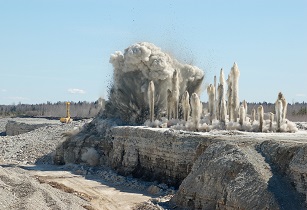Keeping workers and equipment safe from blasting activities is a key concern for the mining industry
It is hardly a ground breaking assertion that the use of explosives presents one of the most hazardous activities conducted by mining companies. While such methods – commonly used to blast and loosen rock – are rarely responsible for the bulk of injuries that befall workers on African mines, when explosive accidents do occur, they can be very destructive, potentially causing loss of life, significant damage to equipment and delaying progress.
Such occurrences have become less acceptable as mining worker safety increasingly becomes a high priority for governments and mining companies.
According to Indentec Solutions, a leading supplier of wireless solutions, despite developing regions tending to lag behind in minimising mining fatalities and injuries, efforts are being pursued globally to improve mining safety standards, ensure worker well-being and generally there is a growing awareness of the importance of safety culture in mining.
Contributing to this effort, last year the company provided its own best practice guide on blast mitigation to increase safety in mines and tunnels. The piece outlines critical points to help protect facilities, assets and people from the impacts of blasts such as the vital importance of risk assessment. Describing this as a ‘crucial tool’, proper risk assessment will provide critical insights into potential threats and advise on best action to produce effective mitigation strategies and protect the stability of mines.
The piece also indicated the pivotal role of understanding materials. Materials with higher tensile strength tend to have better resistance to blast forces and understanding the characteristics of materials in the face of explosions will help predict outcomes. With a deeper understanding of materials’ behaviour, mining professionals can make informed choices regarding selection, placement and reinforcement to enhance blast resistance and mitigation strategies.
Also pertinent is the focus on security, with robust processes crucial to protecting workforces. Indentec highlighted key processes such as creating a safe perimeter around blast areas; screening individuals before entering blast areas – preferably with the use of metal detectors or explosive trace detections – to identify risks or hazards; and establishing efficient evacuation procedures (practiced through drills) to ensure orderly evacuation in the event of an imminent blast as all measures which can minimise risk.
Finally, the opinion piece stressed the importance of selecting the right technology which will correctly balance cost, availability and safety for operations. It highlighted that there are a range of products specifically designed to withstand the unique forces and demands for explosions and research is continually being conducted to validate the effectiveness of blast mitigation products and enhance their potency.
Safe, reliable products
Indeed, there are few companies that provide mining explosive products which have not placed safety as a central tenet defining their products. For instance, BME, a leading provider of explosives and blasting technology, celebrated a key safety target earlier this year when it achieved a zero recordable case rate (RCR) for the year ending January 2023. The RCR is based on the number of incidents resulting in treatment beyond first aid and was driven by a range of safety interventions such as visual felt leadership, process safety, near-miss reporting, driver awareness programmes and fatigue management.
This commitment to safety is reflected in the company’s products with the AXXIS Titanium and AXXIS Silver prime examples. BME managing director, Ralf Hennecke, stated, “Safety in blasting has less to do with automation, and more to do with strict safety protocols supported by the best technology available. For example, our latest generation of AXXIS Titanium once again raises the safety bar by incorporating a Swiss-designed application-specific integrated circuit chip in our detonators. This gives the system more internal safety gates against stray current and lightning, enhancing safety levels and allowing for inherently safe logging and testing.”
BME is not alone here, as Orica, another provider of commercial explosives and blasting systems, has sought to “change how the industry blasts” with its wireless primer launched earlier this year. The Orica WebGen 200 Surface enables customers to optimise their mining process from reducing exposure on bench to geological hazards such as stemming dust, working next to highwalls, reducing vehicle interactions, and removing people from harm's way. In addition, the safe passage of mining equipment over loaded blastholes by maintaining parallel mining, and drilling, and loading activities is now a reality and customers have the ability to continue operations even during lightning storms. Such capabilities mean the technology represents a step forward in reducing production delays as well as delivering robust safety and reliability.
For more in-depth articles about the topics defining Africa's mining industry, including the annual West Africa Mining Report and the growing drilling demand, see the latest issue of African Review at: https://www.africanreview.com/magazine-archives/african-review-august-2023





















